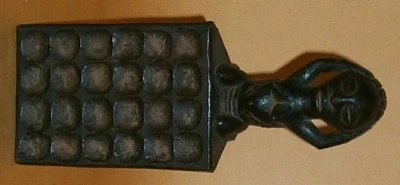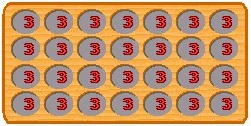| Kisolo |
| Other Names: Cisolo, Kissoro |
| First Description: V. L. Cameron, 1878 |
| Cycles: Two |
| Ranks: Four |
| Sowing: Pussa Kanawa |
| Region: D. R. of the Congo |
Kisolo (also called Cisolo in Kasai) is played by the Luba, Lulua and Songyes in the southeast of the Democratic Republic of the Congo.
Kisolo appears to be related with Coro, a game played in Uganda. It also reminds of some games known in Eastern Africa and of Indian mancala games.
The wooden boards of the Luba are often adorned with human figures which is quite rare in this part of Africa. The holes are usually round, except in Shaba where they are sometimes quadratic. The seeds that are used in play are either from the ngola tree (Pictantus makombo) or from the menga (Canarium schweinfurtii).
Luba board
Rules
Kisolo is mostly played on a 4 x 7 board, but smaller boards are also used such as 4 x 6 (see above). Each player only plays on the two rows which are closest to him.
Initially there are three seeds (makombo) in each hole.
Initial Position
If a player cannot capture, he starts his turn by emptying one of his holes and then distributes its contents one by one counterclockwise into the following holes. When he can't capture (see below), he makes a new lap by distributing the contents of the hole following the hole in which he dropped the last seed in hand. The move ends when the last hole is followed by an empty one.
It is either possible to capture before the actual move starts or during a move.
If, at the beginning of a turn, two inner holes (one from each player) opposite to each other contain seeds, the enemy seeds of the opposite hole and, if there are any, of the enemy hole of the same file behind it are picked up and then distributed counterclockwise on the own side. The first seed must be put into the hole which effected the capture. This kind of capturing is compulsory, but the player is free to decide from which holes he captures when he has more than one choice.
If the last seed falls into a non-empty hole and the following hole is in the inner row and contains seeds, the contents of the opposite enemy hole in the opponent's inner row are captured and also the seeds in the outer enemy hole just behind it. Again, the captured seeds are distributed on the player's own side, starting in the hole which effected the capture (that is, straight opposite the captured holes).
The player who captures all seeds of his opponent's inner holes is declared winner, no matter how many seeds his opponent still has in his outer row. The game is a draw, if a move doesn't end. Perpetual sowing occurs, for instance, if empty holes alternate with holes containing one seed, when at the beginning of the turn, no two inner holes opposite of each other have seeds.
Quote
"Daba didn't understand the cause for this hostility. The whole day he stayed on a bench in the shadow of a mango tree, once he spent his time with Kisolo players."
Pierre Makombo Bamboté (1966)
References
- Avelot, R.
- Le Jeu des Godets. In : Bulletin de la Societé d'Anthropologie de Paris 1907 ; 7 (5).
- Bamboté, P. M.
- Randonnées de Daba de Ouadda à Bangui. Dakar (Senegal), Paris (France) 1966, 44.
- Cameron, V. L.
- À travers l'Afrique: Voyage de Zanzibar à Benguela. Éditions Hachette, Paris (France) 1878.
- Centner, T. H.
- L'Enfant Africain et ses Jeux dans le Cadre de la Vie traditionelle au Katanga. In : Collections Mémoires CEPSI. Elisabethville (Democratic Republic of the Congo) 1963: No. 17.
- Godart, L. & Goubé, C.
- De l’esclavage à la liberté. L’œuvre de libération de la Mission Sainte Famille. Saint-Paul, Bangui (Central African Republic) 1987.
- Mabou, M.
- Culture locale et organisation de l’espace urbain de Bangui (Centrafrique) (Doctoral Thesis). Université de Provence, Aix-Marseille (France) 1995.
- Quefeléc, A.
- Le Français en Centrafrique: Lexique et Societé. EDICEF / AUFELF, Vanves (France) 1997.
- Russ, L.
- The Complete Mancala Games Book: How to Play the World's Oldest Board Games. Marlowe & Company, New York (USA) 2000, 120-121.
- Townshend, P.
- Les Jeux de Mankala au Zaïre, au Ruanda et au Burundi. In: Les Cahiers de CEDAF / ASDOC Studies. Institut Africain. CEDAF / Africa Instituut-ASDOC, Tervuren (Belgium) 1977 (3): 13-14.
- Tshilolo Kabika, M.-J.
- Matricide (review). L'Harmattan, Paris (France) 2008.
- Yavoucko, C.
- Crepuscule et defi, kite na kite. L'Harmattan, Paris (France) 1979.
Copyright
© Wikimanqala.
By: Ralf Gering.
Under the CC by-sa 2.5.

